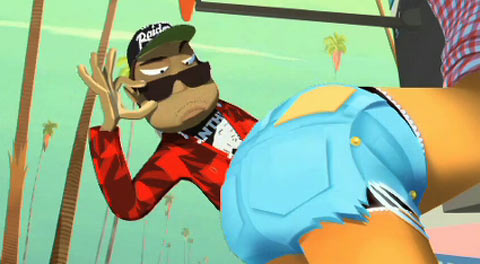

2024 Oscars Short Film Contenders: ‘A Kind of Testament’ Director Stephen Vuillemin
Welcome to Cartoon Brew’s series of spotlights focusing on the animated shorts that have qualified for the 2024 Oscars. There are several ways a film can earn eligibility. With these profiles, we’ll be focusing on films that have done so by winning an Oscar-qualifying award at an Oscar-qualifying festival.
Today’s short is A Kind of Testament from Stephen Vuillemin, which earned its Oscar qualification by winning the Go Short Award at the Go Short International Short Film Festival in Nijmegen, Netherlands. It also impressed at Zagreb – winning the Zlatko Grgic Award for best first professional film – and the Berlinale, where it screened in the short film competition.
In the haunting short, a young woman finds animated videos on the internet that were created using her private selfies. After investigating, she contacts a stranger with the same name who confesses to stealing her identity, but larger questions loom that may never be answered. Unsettling music and sound effects clash with gorgeous illustrations, creating a viewing experience that forces the audience to share the protagonist’s unease.
Cartoon Brew: You’ve said that you intentionally wanted the voice-over the audience hears and the animation it sees to tell two different versions of the same story. Where did that idea come from, and how did that affect the way you developed the script?

Stephen Vuillemin: It was more about using the voice-over to give the animation a context, like in a “making-of” video: “This is the context in which these images were made.” But in my film, there is just as much drama with what the voice-over says as within the animation itself. It is the voice of a woman who was stalked online and then drawn into the main character of the weird, grotesque illustrations you’re seeing. It was about embedding several levels of fiction together (because none of it is true; the characters are all fictional). It works like an infinite sandwich of documentary and fiction because it’s supposedly based on reality (her Facebook pictures), made into fiction (the weird animation), and presented as a documentary (the voice-over), but it’s actually all fiction. All but for one fact: the animated pictures you’re seeing exist, and they took years to make.
I realize this might not make too much sense when you haven’t actually seen the film!
What was it about this story or concept that connected with you and compelled you to direct the film?
The film tells the story of a woman who spent years making animation alone. It really goes hand in hand with how the film was made. It’s my first film, and I started making it when I was 30. Until then, I was playing the Euromillions most weeks, hoping that winning the jackpot would let me make a film. Turning 30 made me question my life decisions, and I realized that I could just do it alone, without the Euromillions jackpot. At the time, having worked as a designer/animator/illustrator for almost 10 years, I had the necessary skillset. All I needed was time, a lot of time. So, I almost stopped socializing. I started turning down as many jobs as possible, and I spent my time making the film instead. After four and a half years, I joined the young company Remembers and had the pleasure of finishing it with them.
What did you learn through the experience of making this film, either production-wise, filmmaking-wise, creatively, or about the subject matter?
It was a very formative, happy life experience. I got to make the exact film I wanted without any time and money constraints (at least in the first five years), which is a rare opportunity. Due to the extended timeline, I had the chance to read all of Proust’s work, some of it as audiobooks while drawing, and I also learned Mandarin Chinese. I had a chance to work with people I had wanted to work with for a long time (Kerhao Yin, who did the costumes; Qoso and Jack Willie, who did the music; Krampf, who did the sound design) and also met many fantastic, talented new people along the way (the producers and animation crew at Remembers, the voice actresses Angela Clerkin and Naomi Yang).
Can you describe how you developed your visual approach to the film? Why did you settle on this style/technique?
I had been developing this style for years as an animator, illustrator, and comics artist. For the film, I wanted to take it even further in terms of richness and details. I wanted to let the audience feel that it did obviously take a lot of time to draw it all. The film is designed as a modern “vanitas” (as in the painting genre): a display of the artist’s skills but also a reminder that beauty and art aren’t much in the face of time and, eventually, death.
This interview was edited for length and clarity.



